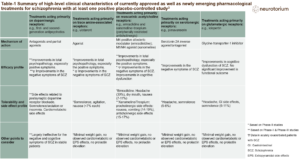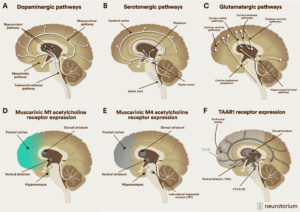Index for
slide deck
Introduction
-1024x576.jpg)
Comorbidity
Schizophrenia, although Schizophrenia, although a disabling disorder in itself is associated with a host of comorbidities that further burden the patient.
-1024x576.jpg)
The comorbidities of schizophrenia
Schizophrenia, although a disabling disorder in itself, is associated with a host of comorbidities that further burden the patient.[APA, 2013; Buckley et al., 2009; Tsai & Rosenheck, 2013] These include psychiatric and somatic conditions.[Buckley et al., 2009; Tsai & Rose…
-1024x576.jpg)
Swedish national cohort study of schizophrenia comorbidities
The correction of the results for potentially confounding variables in this study was an important control step.[Crump et al., 2013] The variables that were adjusted for included: age, marital status, education level, employment status, and income.[Crump et al., 2013] Sep…
Psychiatric comorbidities
-1024x576.jpg)
Psychiatric comorbidities
-1024x576.jpg)
Cognitive dysfunction
The diagnostic criteria for schizophrenia specify negative and cognitive symptoms.[APA, 2013, pgs. 99 & 101] These include diminution in aspects of memory, executive functioning, and processing.[APA, 2013, pg. 101] Although an aspect of schizophrenia, it is noted that the…
-1024x576.jpg)
Depressive disorders
Major depressive disorder (MDD) is characterised by a period of at least two weeks during which an individual displays either low mood, or diminished interest or pleasure.[APA, 2013, pg. 163] There is a collection of associated symptoms, some of which must also be present…
-1024x576.jpg)
Bipolar disorder
Bipolar disorder is a manic–depressive illness, whereby individuals experience periods of depression characterised by low mood, and mania characterised by elevated, expansive, or irritable mood.[APA, 2013, pg. 124] Bipolar disorder must be distinguished from schizophrenia…
-1024x576.jpg)
Sleep disorders
The patient survey described on slide recruited 15 patients with a psychotic disorder, 8 of whom were diagnosed with schizophrenia.[Faulkner et al., 2017] Semi-structured interviews were conducted, lasting between 30 and 110 minutes, focussing on the patient’s experiences…
-1024x576.jpg)
Anxiety disorders
Fear is a normal response to certain stimuli; it is an emotional response to either a real or a perceived imminent threat; anxiety is simply the anticipation of that future threat.[APA, 2013, pg. 189] The anxiety experienced within an anxiety disorder is more persistent t…
-1024x576.jpg)
Panic disorder
Panic disorder refers to a condition whereby an individual suffers from unexpected attacks of panic symptoms, including: palpitations, sweating, trembling, shortness of breath, choking feelings, chest pain or discomfort, nausea, dizziness, chills, numbness or tingling, de…
-1024x576.jpg)
Obsessive–compulsive disorder
Obsessive-compulsive disorder (OCD) is associated with reduced quality of life, and functional impairments.[APA, 2013, pg. 240] It is defined as:[APA, 2013, pg. 237]
- obsession; recurrent and persistent thoughts, urges, or images, that are experienced as unwanted or intr…
-1024x576.jpg)
Substance use disorder and schizophrenia
Substance-use disorders are a group of cognitive, behavioural, and physiological symptoms indicating that the individual continues to use a substance despite problems related to the use of that substance.[APA, 2013, pg. 483] Substances can include alcohol, cannabis, hallu…
-1024x576.jpg)
Smoking
Although smoking may alleviate some of the symptoms of schizophrenia, cigarette smoking is a modifiable risk factor for a whole host of physical conditions, including cardiovascular disease, and cancer.[APA, 2013, pg. 574; De Hert et al., 2011]
References:
American Psych…
-1024x576.jpg)
Cannabis use
Cannabis-use disorder is characterised by a patient exhibiting a problematic pattern of cannabis use that leads to clinically significant impairment, or to distress.[APA, 2013] Cannabis use is often reported to be a form of self-medication, in order to cope with mood diso…
-1024x576.jpg)
The consequences of substance use disorder in schizophrenia
Comorbid substance use represents a barrier to carrying out effective treatment for schizophrenia, and is associated with its own set of health problems.[Winklbaur et al., 2006] As well as reducing the likelihood of good treatment outcomes, comorbid substance use in patie…


-1024x576.jpg)
-1024x576.jpg)
-1024x576.jpg)
-1024x576.jpg)
-1024x576.jpg)
-1024x576.jpg)
-1024x576.jpg)
-1024x576.jpg)
-1024x576.jpg)
-1024x576.jpg)
-1024x576.jpg)
-1024x576.jpg)
-1024x576.jpg)


